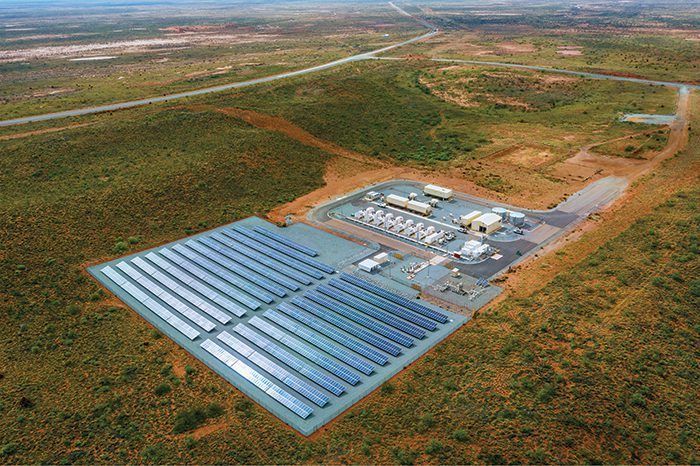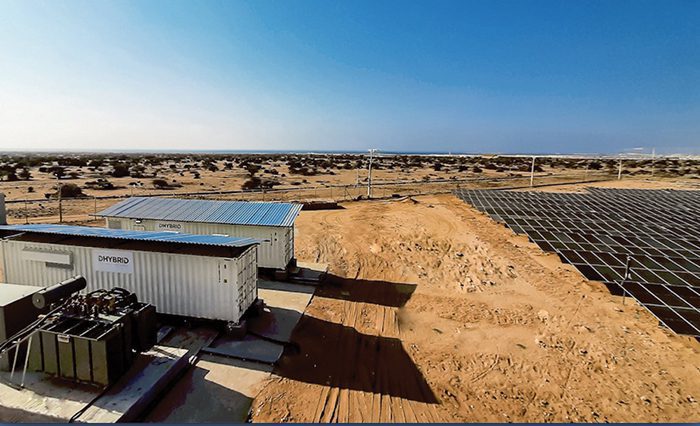Communities Benefit from Microgrid Milestones
The post Communities Benefit from Microgrid Milestones appeared first on POWER Magazine.

A remote area in Australia recently recorded an important power generation achievement, as the region received all its electricity from solar power and battery energy storage. The town of Onslow, located in the state of Western Australia, was powered for about 80 minutes solely by solar-plus-storage thanks to advanced microgrid technology that determined the best time and conditions to draw energy only from the town's solar resources supported by a battery energy storage system (BESS). The set-up is part of a collaboration between PXiSE Energy Solutions, a grid management technology company and subsidiary of Sempra Energy, and Horizon Power, Western Australia's regional power provider.
PXiSE is providing Horizon Power with advanced microgrid control technology, along with a distributed energy resources management system (DERMS), to manage Onslow's solar and traditional energy sources. Onslow's grid operator utilized the microgrid control tech and DERMS to determine when to draw energy only from the town's solar resources. Residents played a key role in reaching the 100% solar-plus-storage milestone, with more than 40% of the town's homes having solar panels that generate power for the grid.
 |
1. A solar array in Onslow in Western Australia is paired with energy storage and a microgrid control system, supporting the power supply and grid stability of the remote community. Courtesy: Horizon Power |
PXiSE and Horizon have touted the project (Figure 1) as showing that it is possible for communities to operate entirely on a solar-plus-storage energy model, which could provide a way for other remote communities worldwide to gain more access to electricity, along with supporting the reliability of the power supply. The Onslow demonstration provides a blueprint for such installations, and other groups are designing similar projects. German microgrid tech company DHYBRID in late June announced a solar-plus-storage scheme to support the local grid in the Somaliland port city of Berbera, the capital of that country's Sahil region.
Horizon Power has been a leader and early adopter of microgrids, as their service area is five times the size of California but populated by remote, isolated communities," said Patrick Lee, president and CEO of PXiSE, noting that Horizon Power's system includes 32 microgrids. The utility delivers electricity to more than 110,000 homes, communities, and businesses across a remote, isolated region.
Lee told POWER that concerns over system stability of the microgrids have constrained the addition of customer-owned solar assets. When temperatures reach over 40 degrees Celsius/104 degrees Fahrenheit, and sunshine is abundant, it's tough to tell customers that their solar can't be added due to grid limitations. With a mandate to add more renewables, Horizon's options were to make expensive infrastructure augmentations or add a DERMS, which uses software to balance traditional energy assets with customer-owned DERs like solar panels." Lee said the DERMS provides a solution to maximize solar integration into Onslow's microgrid, paving the way for even more renewables in Onslow and elsewhere. This is a significant milestone for energy control technology and renewable energy, with broad applications for the world at large," Lee said.
Energy providers, particularly those in areas seeking more reliable power, are looking at advanced microgrid control technology and DERMS as a way to provide more renewable energy resources to communities without experiencing grid stability issues. The Onslow project, which was two years in the making, began when Horizon Power commissioned PXiSE to deploy the DERMS and PXiSE's own Microgrid Controller. Horizon's engineers are now able to monitor Onslow's grid in real time, managing generation from the town's many distributed solar power resources and a traditional gas-fired power plant.
The 100% solar-and-storage achievement came as part of a demonstration, with the town served by about 700 kW of domestic solar from more than 260 customers; 600 kW of utility solar; a grid formed by a power station battery storage system; and solar smoothing support from a zone substation battery. The microgrid control technology, in coordination with the substation's power line controller, smoothly managed power transitions to ensure steady-state frequency and voltage. The DERMS managed the residential solar and provided predictive analytics for solar/weather conditions, informing the transition criteria.
The companies told POWER in a statement that the breakthrough was the exclusive use of household rooftop and utility solar assets, which are non-dispatchable energy sources, and precisely coordinating that with energy storage resources and load and weather forecasts to provide stable, continuous, high-quality power to a grid. The town did not need to draw power from its fossil-based plant, nor is there any hydropower in the region. Such a model could be applied in any area to go towards 100% renewable."
Bill Johnston, energy minister for Western Australia, noted, This innovative project demonstrates how distributed energy resources can be safely integrated at the grid level."
Stephanie Unwin, Horizon Power's CEO, said, Renewable energy solutions are front of mind, and we have very clear goals for our energy future. This technical functionality developed in Onslow continues to lead the industry to overcome the barriers to increased rooftop solar installation, which has been shown to reduce energy costs for our regional customers."
Lee said, This is a significant milestone for energy control technology and renewable energy, with broad applications for the world at large. The DERMS and Microgrid Controller-facilitated hydrocarbon-free period in Onslow demonstrates the possibility for certain communities to run solely on solar plus battery storage."
Jose Carranza, head of Products & Solutions for PXiSE, told POWER: Aside from the breakthrough milestone of the entirely solar-plus-batteries demonstration, the Onslow project has had several other technical achievements. Thanks to significant interest from the residents of Onslow, there's also been a threefold increase in the number of people with rooftop solar installations."
Carranza added, The entire 11-MW microgrid serves a peak load of 4 MW, and its renewable assets include a 1-MW utility-scale solar array; 260 residential arrays totaling 2.1 MW; two 1-MW battery storage systems; and 500 kWh of residential batteries. The recently added solar resources are expected to reduce natural gas consumption by over 55,000 GJ [gigajoule], lowering energy costs for everyone," and reducing emissions of carbon dioxide. Onslow officials also said the project serves as a sustainable energy model for isolated and island communities that lack access to geothermal or hydroelectric resources, showing that remote areas can operate on a solar-plus-storage power model along with a mix of customer- and utility-owned assets.
In Onslow's case, there are gas and diesel power plants supplementing solar, and our DERMS and microgrid controller helped Horizon Power's engineers determine when it's ideal to pull power from the solar assets without disrupting the grid," Lee told POWER. When the engineers recently configured the control system to power the town solely from the solar arrays and batteries, it proved the feasibility to operate a highly renewable and distributed grid in remote communities and islands anywhere in the world. Not only is it possible to accelerate a large quantity of renewables and DERs into existing power grids, but intermittent renewables like solar can be safe and reliable sources of energy on standalone microgrids when paired with a modest amount of energy storage and enabled by the latest energy control technology."
 |
2. Germany-based DHYBRID has installed a hybrid power system in the Somaliland port city of Berbera. The design includes a total of 8 MW of solar power generation capacity, along with a 2-MWh containerized battery energy storage system and three diesel generators. Courtesy: DHYBRID |
The DHYBRID project (Figure 2) in Somaliland, across the Gulf of Aden from Yemen, features two solar PV plants with a total 8 MW of generation capacity, along with a 2-MWh containerized lithium-ion BESS and three diesel generators. The system is connected to local utility Berbera Electricity Co.'s grid.
DHYBRID-a German company that specializes in hybrid power systems-supplied microgrid monitoring and controls technology, including its open-technology Universal Power Platform, and a supervisory control and data acquisition system. The group said the BESS is likely Somaliland's largest to date, and supports grid stability. The microgrid has enabled the increase of distribution load-bearing capacity and efficiency of power generation," according to the company. DHYBRID said the city grid's power factor has improved by 20% with the addition of the microgrid.
It's an important project for Berbera, which is expanding its port operations and has sought ways to integrate new solar power generation capacity and improve the reliability of its power supply. Various generators within the grid must be continuously coordinated, especially when renewable energies are involved. Otherwise, problems with the grid frequency and voltage will become unavoidable, making it impossible to utilize all the available power," DHYBRID CEO Benedikt Bohm said in a statement. It is simply not enough to just consider the solar capacity available. Effective grid management is essential."
-Darrell Proctor is a senior associate editor for POWER (@POWERmagazine).
The post Communities Benefit from Microgrid Milestones appeared first on POWER Magazine.